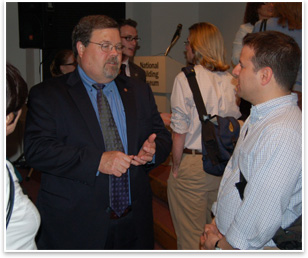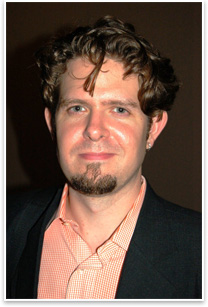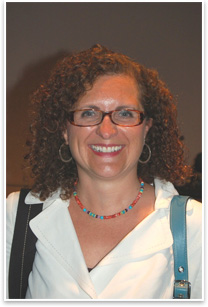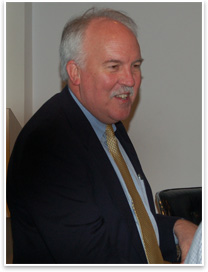Panelists Debate Green Preservation
AIA 21st Century Workplace cited as next best example
by Steve Freeman
Contributing Editor
 Summary: Like the AIA headquarters building in Washington, D.C., the vast majority of America’s existing buildings will require renovation in coming years, raising issues of how to accomplish historic preservation, if appropriate, as well as meet industry-backed sustainability goals. Summary: Like the AIA headquarters building in Washington, D.C., the vast majority of America’s existing buildings will require renovation in coming years, raising issues of how to accomplish historic preservation, if appropriate, as well as meet industry-backed sustainability goals.
That was the issue addressed by experts at an educational program—“Preserving Modernism in a Green World”—at the National Building Museum on June 30. Vernon Mays served as moderator for the program.
A great experiment
While such Modern gems as the Lever House, the Seagram Building, and Boston City Hall were discussed, the presenters implied that the AIA’s 21st Century Workplace project is the “must watch” experiment for now. AIA plans to renovate its 35-year-old, 8-story office building in the nation’s capital and meet aggressive sustainability and historic preservation goals in the process.
Citing the AIA’s “bravery in setting up a problem for themselves,” Abram Goodrich of Studios Architecture, architect for the AIA project, said: “We’re going to push it to the limit, hoping to achieve a carbon-neutral building by 2030…and we also want it to be a candidate for National Registry status.”
 Representing the AIA was Jim Gatsch, FAIA, managing director of the 21st Century Workplace project. “We hope this project will demonstrate how significant urban buildings can be preserved and renewed and remodeled in an exemplary way,” he said. Representing the AIA was Jim Gatsch, FAIA, managing director of the 21st Century Workplace project. “We hope this project will demonstrate how significant urban buildings can be preserved and renewed and remodeled in an exemplary way,” he said.
Typical energy consumption concerns
The AIA headquarters building—completed in 1973—is typical of Modern buildings constructed after World War II and before 2000. Its design and materials fit the era characterized by experimentation…and high energy consumption and carbon emissions as well.
Plans are to update the 180,500-square-foot building’s aging mechanical systems, modernize its work spaces, and make changes in structure, operations, and maintenance to reduce energy use and carbon gas emissions by 60 percent by 2012. The latter goal is the AIA’s first step to occupying a carbon-neutral building by 2030.
Buildings that came on line between 1960 and 1999 are the worst offenders in terms of energy use, said Christopher Davis, Assoc. AIA, LEED-AP, a LEED certification coordinator for the U.S. Green Building Council. He defined for the audience details about the revised LEED for Existing Buildings rating system, focusing on operations and maintenance and due out August 1.
“We can’t solve the energy crisis if we don’t look at existing buildings,” said Davis. “New buildings meeting LEED specifications will only affect 1 percent of all buildings. That’s why this new rating system is coming along.”
According to Davis, U.S. buildings cause 12 percent of the nation’s water consumption, 39 percent of CO2 emissions, 65 percent of waste output, and 71 percent of electricity consumption in this country.
 Early days of design stage Early days of design stage
Stressing that no specific details or decisions on design or operations have been made, Goodrich mentioned various possible alternatives, natural ventilation, solar strategies, and roofing.
Getting cool, fresh air in the building—and decreasing the use of energy pulled by the HVAC system—could be achieved by major modifications to the building. Although the structure has no operable windows or major ventilation outlets today, plans could change that. “We could open the skin of the building and take the hot air out” by installing paths for air to enter and leave the building, Goodrich said. That could involve creating four shafts through the building and exhausting hot air above the roof. “Natural ventilation is on the table because of the aggressive energy goals,” he added.
The shafts could also provide sunlight internally, saving on the electric bill. In addition, the design team may consider solar shades and light shelves to redirect daylight on the ceilings inside.
The building’s roof—a major collector of the sun’s heat on any building—is another concern for the architect. To alleviate the cooling problem, the design could call for highly reflective coatings, or turning it into a “green roof,” filling the surface with greenery, thereby embargoing sunlight.
Gatsch concurred. “A lighting system, using solar thermal and water HVAC systems: These will get us most of the way to 2012 goals … And we expect technology will improve in the next few years so we’ll meet 2030 goals,” he said, referring to advances in photovoltaics and wind harvesting as examples.
But first, the AIA’s plan will likely concentrate on reducing building plug loads, updating programs for use of space, increasing insulation, and eliminating single-pane glazing around the building.
 The old, the Modern, and the new The old, the Modern, and the new
Equally challenging to Goodrich is protecting the relationship between the Modern-era building and its neighbor, the Octagon House. The Octagon is a historic property, built at the same time as the White House a short distance away. It is owned by the American Architectural Foundation (AAF) and represents a critical element on the AIA campus.
For Goodrich, the issue is obvious. “We are trying to strengthen the relationship between the AIA building and the Octagon while making significant energy reduction elements to the newer campus building. We need to establish the defining characteristics and be sure to reinforce them in the renovations.”
That’s an ongoing debate, said a fourth presenter, Barbara Campagna, AIA, LEED-AP, and the Graham Gund Architect of the National Trust for Historic Preservation. “How do we balance saving the planet and saving historic structures? We must ask ourselves, do we have to restore experimental materials and assemblies?”
Windows and curtain-wall systems are worthy considerations for achieving preservation and improved design and performance. Campagna said that original windows do not enhance the energy loss targets of the original floors, walls, and ceilings of buildings. As an example of this dilemma, she noted that many designers must determine whether to re-install plate glass windows when tempered glass is safer and often undetectable from the originally installed plate glass.
Campagna said curtain walls in Modern buildings are a key source of energy loss, in part because they were not designed to provide insulation. But replacing curtain walls is also problematic because gaskets and connectors were all one piece in days-gone-by.
“I [am] really intrigued by your [proposed] light-shelf idea,” Campagna said of the speculation about the AIA project. “Is it a character-defining element? You have long expanses of strip windows. My other question is: What if you do that, it looks great, and you are carbon-neutral by 2030?” To Davis, preservation and sustainability are closer than some think. “Preservation is about conserving the past; sustainability is about conserving the future,” she said
The nature of the AIA project, said Goodrich, is to demonstrate a thorough willingness to pursue innovation. “But what if that jeopardizes the achievement of our goals?” |


 Summary:
Summary: Representing the AIA was Jim Gatsch, FAIA, managing director of the 21st Century Workplace project. “We hope this project will demonstrate how significant urban buildings can be preserved and renewed and remodeled in an exemplary way,” he said.
Representing the AIA was Jim Gatsch, FAIA, managing director of the 21st Century Workplace project. “We hope this project will demonstrate how significant urban buildings can be preserved and renewed and remodeled in an exemplary way,” he said. Early days of design stage
Early days of design stage The old, the Modern, and the new
The old, the Modern, and the new